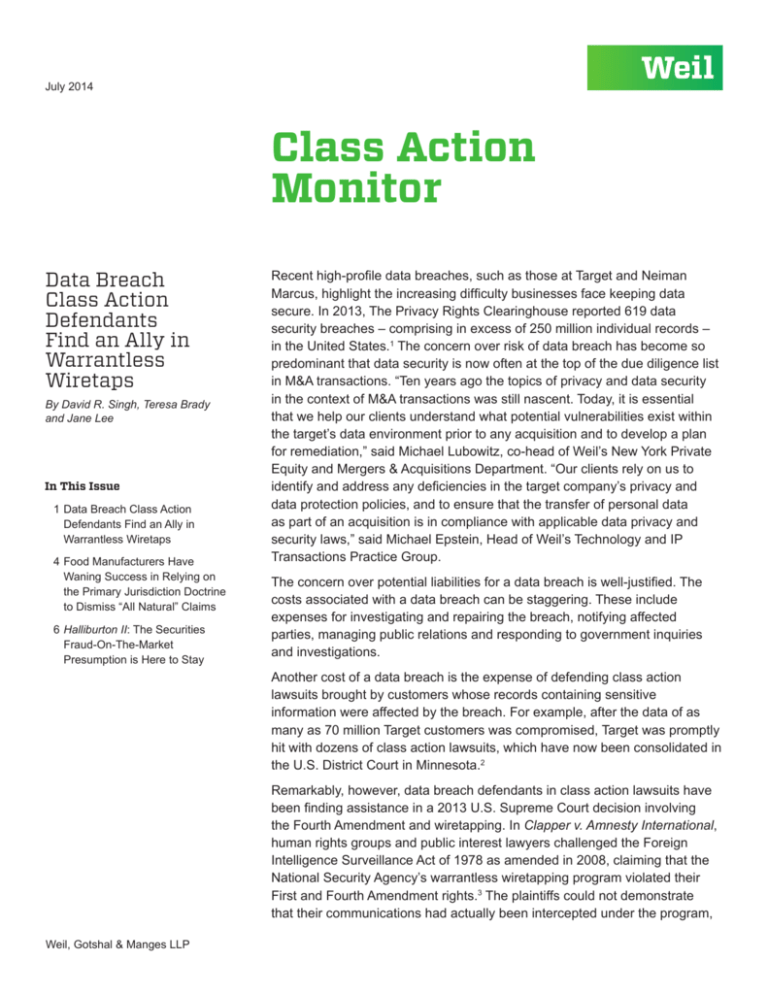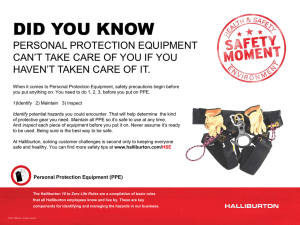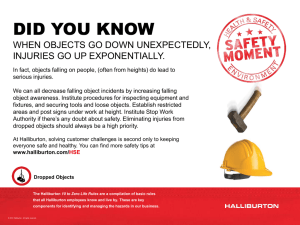
July 2014
Class Action
Monitor
Data Breach
Class Action
Defendants
Find an Ally in
Warrantless
Wiretaps
By David R. Singh, Teresa Brady
and Jane Lee
In This Issue
1Data Breach Class Action
Defendants Find an Ally in
Warrantless Wiretaps
4Food Manufacturers Have
Waning Success in Relying on
the Primary Jurisdiction Doctrine
to Dismiss “All Natural” Claims
6Halliburton II: The Securities
Fraud-On-The-Market
Presumption is Here to Stay
Recent high-profile data breaches, such as those at Target and Neiman
Marcus, highlight the increasing difficulty businesses face keeping data
secure. In 2013, The Privacy Rights Clearinghouse reported 619 data
security breaches – comprising in excess of 250 million individual records –
in the United States.1 The concern over risk of data breach has become so
predominant that data security is now often at the top of the due diligence list
in M&A transactions. “Ten years ago the topics of privacy and data security
in the context of M&A transactions was still nascent. Today, it is essential
that we help our clients understand what potential vulnerabilities exist within
the target’s data environment prior to any acquisition and to develop a plan
for remediation,” said Michael Lubowitz, co-head of Weil’s New York Private
Equity and Mergers & Acquisitions Department. “Our clients rely on us to
identify and address any deficiencies in the target company’s privacy and
data protection policies, and to ensure that the transfer of personal data
as part of an acquisition is in compliance with applicable data privacy and
security laws,” said Michael Epstein, Head of Weil’s Technology and IP
Transactions Practice Group.
The concern over potential liabilities for a data breach is well-justified. The
costs associated with a data breach can be staggering. These include
expenses for investigating and repairing the breach, notifying affected
parties, managing public relations and responding to government inquiries
and investigations.
Another cost of a data breach is the expense of defending class action
lawsuits brought by customers whose records containing sensitive
information were affected by the breach. For example, after the data of as
many as 70 million Target customers was compromised, Target was promptly
hit with dozens of class action lawsuits, which have now been consolidated in
the U.S. District Court in Minnesota.2
Remarkably, however, data breach defendants in class action lawsuits have
been finding assistance in a 2013 U.S. Supreme Court decision involving
the Fourth Amendment and wiretapping. In Clapper v. Amnesty International,
human rights groups and public interest lawyers challenged the Foreign
Intelligence Surveillance Act of 1978 as amended in 2008, claiming that the
National Security Agency’s warrantless wiretapping program violated their
First and Fourth Amendment rights.3 The plaintiffs could not demonstrate
that their communications had actually been intercepted under the program,
Weil, Gotshal & Manges LLP
Class Action Monitor
only that there was a possibility they could be.4
The Supreme Court held that the plaintiffs’ “highly
speculative fear” that their communications were
being intercepted under the wiretapping program was
insufficient to establish plaintiffs’ standing to bring the
claims because standing requirements can be met
only by showing actual harm or “certainly impending”
injury.5 The Court rejected the Clapper plaintiffs’
alternative argument that they could establish
standing based on the costs they had expended to
protect the confidentiality of their communications, for
example by traveling to have in-person conversations,
because of the threat of surveillance.6 “(Plaintiffs)
cannot manufacture standing merely by inflicting harm
on themselves based on their fears of hypothetical
future harm that is not certainly impending.”7
Since the Clapper decision, numerous federal district
courts around the country have cited Clapper’s
definition of injury for purposes of standing as a basis
for dismissing or denying class certification in data
breach cases on the grounds that consumers cannot
establish standing based on either the possibility that
their personal information may be misused or the
costs they have incurred to monitor their credit reports
for unauthorized charges. The first court to apply
Clapper in a data breach case was the U.S. District
Court for the Northern District of Illinois in In re Barnes
& Noble Pin Pad Litig., 12-CV-8617, 2013 WL 475988
(N.D. Ill. Sept. 3, 2013). In that case, plaintiffs filed
a putative class action complaint against Barnes &
Noble after “skimmers” collected credit and debit card
information from the retailer’s PIN pads. The Barnes
& Noble plaintiffs alleged that their injuries stemmed
from a loss of privacy, improper disclosure of their
personal information, and all expenses incurred
to mitigate the risk of future identity theft or fraud.8
Applying Clapper, the court dismissed their claims
for lack of standing and held that an increased risk
of identity theft or fraud did not amount to an actual
injury.9 Without pleading and proving concrete facts
that their personal information had actually been
stolen, the court found that “the inference that their
data was stolen, based merely on the security breach,
is too tenuous to support a reasonable inference that
can be made in Plaintiffs’ favor.”10
Weil, Gotshal & Manges LLP
Applying similar reasoning, an Ohio federal court
denied class certification in Galaria v. Nationwide
Mutual Insurance Co., Case No. 2:13-cv-118 (S.D.
Ohio Feb. 10, 2014), finding that plaintiffs did not
sustain an injury sufficient to confer standing. In
Galaria, plaintiffs asserted putative class claims
against Nationwide Mutual Insurance for negligence,
invasion of privacy, bailment, and violations of the
Fair Credit Reporting Act after a hacking incident
caused their personal identifiable information to be
stolen from the network. They alleged that their injury
was in the form of an increased risk of identity theft,
identity fraud, and medical fraud as a result of the
data breach, as well as any costs incurred to monitor
and mitigate such risks.11 Applying Clapper, the
court found that plaintiffs did not allege an adequate
injury-in-fact since they did not suffer any adverse
consequences from the data breach. Had plaintiffs
alleged that their personal information was misused
or that their identities were stolen, plaintiffs may have
had standing. Allegations of possible future injury,
however, were too speculative to confer standing.
Furthermore, the court held that any expenses
incurred to monitor and prevent identity theft were
not actual injuries because they were equivalent to
the “manufactured standing” that the Clapper court
rejected. Federal courts in New Jersey, Illinois and the
District of Columbia have similarly applied Clapper
to dismiss data privacy breach cases for lack of
standing.12
It should be noted, however that the District Court in
the Southern District of California recently departed
from the prevailing approach when it allowed a class
of breach plaintiffs to survive a motion to dismiss
based on a possibility of future harm. In In re Sony
Gaming Networks and Customer Data Security,
MDL 11-MD-2258 AJB (MDD), 2014 WL 223677
(S.D. Cal. Jan. 21, 2014) (“Sony II”), plaintiffs sued
Sony Corp. after discovering that hackers accessed
Sony’s network and stole user information, alleging
injuries arising from Sony’s misrepresentations
about its security, the circumstances of the breach,
the loss of online services, and an increased risk of
identity theft.13 The court denied Sony’s motion to
dismiss, finding that plaintiffs’ injuries were sufficient
to establish a “certainly impending” injury.14 In so
July 2014
2
Class Action Monitor
holding, the court explained that whether plaintiffs
actually experienced any misuse of their personal
information was immaterial because Clapper does
not require an actual injury so long as plaintiffs could
show that their injury was “certainly impending.”15
Since plaintiffs alleged that the data breach actually
occurred and their personal information was stolen
and disclosed, the standard had been met.16 To date,
the Sony II decision is the only post-Clapper data
privacy breach case where a federal court has found
standing based on a possibility of future injury.
plaintiffs do not have standing, under Article III of the
U.S. Constitution, to sue in federal court because they
cannot show that they have been injured under the
Clapper definition of injury.
The Sony II decision raises doubt regarding the
presumption that consumer data breach class actions
were doomed after Clapper, and plaintiffs may be
incentivized to file more data breach class actions
in the Southern District of California as a result. In
addition, plaintiffs may file more actions in certain
state courts with relaxed standing requirements.
Recently, the Supreme Court of Appeals of West
Virginia held that a class of plaintiffs did have
standing to sue in a data breach case, despite the
absence of any allegation that plaintiffs suffered
adverse consequences from the breach. Tabata v.
Charleston Medical Center Inc. et al., No. 13-0766
(May 28, 2014). In Tabata, plaintiffs filed a putative
class action asserting causes of action for breach of
confidentiality, invasion of privacy, and negligence
after their personal and medical information was
inadvertently placed on defendants’ public database.17
As a basis for finding standing, the court stated that
patients have a legal interest in protecting their private
information such that the mere disclosure of such
information amounts to an actualized injury.18
4. Id. at 1148.
Data breach defendants sued in state courts applying
less stringent standing requirements, however, would
be well-advised to consider removing the case to
federal court. The Class Action Fairness Act of 2005
(CAFA) requires that class actions involving more
than 100 people and claims of more than $5 million
be litigated in federal court, even if plaintiffs assert no
federal claims; data breach class actions often satisfy
these requirements, especially where plaintiffs seek
penalties or damages under state unfair competition
or deceptive trade practice acts or other statutes.
Once in federal court, defendants should move to
dismiss the class action on the grounds that the
Weil, Gotshal & Manges LLP
1. Chronology of Data Breaches, Privacy Rights
Clearinghouse (accessed June 27, 2014), https://www.
privacyrights.org/data-breach/new.
2. In re: Target Corporation Customer Data Security Breach
Litigation, MDL No. 14-2522 (PAM/JJK).
3. Clapper v. Amnesty Intern. USA, 133 S.Ct. 1138 (2013).
5. Id.
6. Id. at 1150-51.
7. Id.
8. In re Barnes & Noble Pin Pad Litig., 12-CV-8617, 2013 WL
475988, at *2 (N.D. Ill. Sept. 3, 2013).
9. Id. at *5.
10.Id. at *4.
11.Galaria v. Nationwide Mutual Insurance Co., Case No.
2:13-cv-118, 2014 WL 689703, at *2 (S.D. Ohio Feb. 10,
2014).
12.See also, Polanco v. Omnicell, Inc., Civ. No. 13-1417 (NLH/
KMW), 2013 WL 6823265 (Dec. 26, 2013) (dismissing
class action on grounds that mere violation of state statutes
and money spent to avoid future injury did not confer
standing); In re: Science Applications International Corp.
(SAIC) Backup Tape Data Theft Litigation, Misc. Action
No. 12-347 (JEB) MDL 2360, 2014 WL 1858458 (May 9,
2014) (holding that a mere loss of data without evidence
of misuse is insufficient injury for standing); Strautins
v. Trustwave Holdings, Inc., No. 12 C 09115, 2014 WL
960816 (N.D. Ill. 2014) (holding that claims were too
speculative where plaintiff could not establish that her data
was stolen or that anyone attempted to use it).
13.In re Sony Gaming Networks and Customer Data Security,
MDL 11-MD-2258 AJB (MDD), 2014 WL 223677, at *2
(S.D. Cal. Jan. 21, 2014).
14.Id. at *9.
15.Id.
16.Id.
17.Tabata, et al. v. Charleston Area Medical Center Inc. et al.,
No. 13-0766 (May 28, 2014).
18.Id.
July 2014
3
Class Action Monitor
Food Manufacturers Have
Waning Success in Relying
on the Primary Jurisdiction
Doctrine to Dismiss “All
Natural” Claims
By Theodore E. Tsekerides and Melody E. Akhavan
The past few years have seen a notable uptick in
consumer class actions challenging the labeling of
various food products as “all natural.” These suits
can become very expensive very quickly, particularly
because some courts have held that plaintiffs may
have standing to sue for products they did not
purchase, so long as they are substantially similar
to products they did purchase.1 One of the key
issues that has emerged over the last year is when
the primary jurisdiction doctrine can be successfully
invoked by defendant manufacturers to remove
these “all natural” labeling issues from the purview
of the courts. A review of the recent decisions in “all
natural” consumer fraud suits reveals that different
defendants have had varying levels of success
limiting labeling claims by relying on the primary
jurisdiction doctrine. At first blush, some of these
decisions seem inconsistent with one another, but
a closer look reveals a pattern in how district courts
are applying the primary jurisdiction doctrine in “all
natural” labeling suits—a pattern of limited, waning
success for defendants.
The Primary Jurisdiction Doctrine
The primary jurisdiction doctrine is a discretionary
doctrine that “allows courts to stay proceedings or to
dismiss a complaint without prejudice pending the
resolution of an issue within the special competence
of an administrative agency.”2 In deciding whether
to apply the primary jurisdiction doctrine, courts
traditionally weigh the following four factors: “(1) the
need to resolve an issue that (2) has been placed by
Congress within the jurisdiction of an administrative
body having regulatory authority (3) pursuant to
a statute that subjects an industry or activity to a
comprehensive regulatory authority that (4) requires
expertise or uniformity in administration.”3 Weil, Gotshal & Manges LLP
The Current Regulatory Framework
In the context of these “all natural” consumer fraud
suits, the relevant administrative agency is the Food
and Drug Administration (FDA), and the relevant
statute is the Food, Drug, and Cosmetics Act, which
gives the FDA the authority to establish a uniform
federal scheme of food regulation to ensure that
certain food labeling standards are met. To date,
the FDA’s guidance with respect to what “natural”
means in the food labeling context is contained in
non-binding guidance issued in 1993.4 This regulation
defines “natural” as “nothing artificial or synthetic
(including all color additives regardless of source)
has been included in, or has been added to, a food
that would not normally be expected to be in the
food.” The very general language of this guidance,
together with the fact that it is not binding on food
manufacturers, has created much room for debate
over the scope of the “natural” definition, as well as
fertile ground for litigation of this issue.
Plaintiffs’ “all natural” claims can be roughly divided
into three categories that range in specificity: (1)
claims regarding foods that contain genetically
modified organisms (GMOs); (2) claims regarding
foods that contain synthetic ingredients; and
(3) claims regarding products that are allegedly
misleading because they are labeled as containing
“evaporated cane juice” (ECJ) instead of sugar.
Defendants’ success in staying or dismissing food
labeling claims using the primary jurisdiction doctrine
has varied by category.
Genetically Modified Organism Cases
Last year, multiple district courts5 referred to the FDA
the specific issue of whether products containing
genetically modified corn could be labeled as
“natural,” citing the primary jurisdiction doctrine.
These courts acknowledged that no official federal
regulation or rule defines the term “natural” as it
concerns GMOs, and called on the FDA to provide a
definitive interpretation. In January of this year, the
FDA responded6 to these referrals by declining to offer
a formal definition of the term “natural” with respect
to foods, noting that should the FDA wish to formalize
its policy on “natural” foods, it would “not do so in
July 2014
4
Class Action Monitor
the context of litigation between private parties,” but
would rather be handled through a public process.
Subsequently, a New York federal judge rejected
J.M. Smucker Co.’s motion to dismiss a putative
class action contesting the “all natural” label on
Crisco cooking oils that are made using genetically
modified crops.7 J.M. Smucker Co. had argued
that the court should defer to the FDA’s primary
jurisdiction in food labeling. But the court denied the
motion, finding that the FDA’s refusal to consider the
question of whether foods containing GMOs may
be labeled “natural” weighed against siding with the
defendants. Significantly, the court also found that
the question of whether a label is misleading is more
of a legal issue than a scientific one.8 Under this
court’s reasoning, defendants seeking to bypass the
adjudication of “natural” mislabeling claims of GMOcontaining products through the primary jurisdiction
doctrine would be out of luck, unless and until the
FDA announces that it will issue specific guidance
regarding the classification of GMO products.
Synthetic Ingredient Cases
Food manufacturers defending false labeling claims
with respect to foods containing synthetic ingredients
may also have a difficult time successfully relying
on the primary jurisdiction doctrine. For instance, in
Garrison v. Whole Foods Market Group, Inc., No.
13-cv-05222-VC (N.D. Cal. June 2, 2014), a case
in which plaintiffs claimed that several Whole Foods
products were misleadingly labeled “all natural”
when they contained sodium acid pyrophosphate, a
synthetic ingredient, the court found that the primary
jurisdiction doctrine was inapplicable. Finding that
“there is no clear indication the [FDA] intends to revisit
[its decision not to issue a formal opinion on the word
“natural” by means of its January 6, 2014 letter]” there
would be no “resolution of the issue pending before
the Agency to which the Court could defer.” Id. at *3.
The court further held that “allegations of deceptive
labeling do not require the expertise of the FDA to
be resolved ... as every day courts decide whether
conduct is misleading.” This decision echoes the
reasoning of the J.M. Smucker court and dampens
hopes that defendants can rely on courts to defer to
Weil, Gotshal & Manges LLP
the FDA’s potential regulation of the term “natural” in
light of its January 6 letter.
Evaporated Cane Juice Cases
In contrast to GMO and synthetic ingredient cases,
defendants in cases concerning evaporated cane
juice have experienced some success in relying
on the primary jurisdiction doctrine to stay their
proceedings. In these ECJ cases, plaintiffs have
alleged that companies are misleading consumers
when they use the term “evaporated cane juice” on
the ingredient list, because ECJ is nothing more than
added sugar. Significantly, the FDA issued a notice in
the Federal Register on March 5, 2014, re-opening
the comment period for draft guidance on the use
of the term ECJ. The notice indicated that the FDA
would issue a final regulation after the close of the
comment period. In light of this fact, several courts
have dismissed or stayed ECJ suits under the primary
jurisdiction doctrine.9
For example, the court in Swearingen v. Attune
Foods, Inc. granted the defendant’s motion to dismiss
in a case where plaintiffs alleged that the defendant’s
labeling of many of its cereal products violated FDA
regulations because the use of the term ECJ instead
of sugar was deceptive. The court held that “[f]ood
labeling is within the special competence of the FDA,
the FDA has not resolved the issue of whether ECJ is
the common or usual name of the ingredient involved
in this case, the FDA is engaged in active rulemaking
on this issue, and deferring to the FDA for resolution
of this issue will allow courts to benefit from the FDA’s
expertise on food labeling and will ensure uniformity
in administration of the FDA’s regulations.”10 This
reasoning will likely provide relief to defendants
defending ECJ labeling suits.
Conclusion
Ultimately, it has become clear over the past year
that defendants’ opportunities to successfully rely on
the FDA’s primary jurisdiction to stay or dismiss “all
natural” labeling claims are waning. The FDA’s refusal
to define “natural” for the time being has signaled
to several courts that a court’s pronouncement on
whether the “natural” labeling is misleading will
July 2014
5
Class Action Monitor
not interfere with federal policy. This reasoning will
likely apply in the foreseeable future to both labeling
of GMO products and those products containing
synthetic ingredients. Defendants may find relief,
however, in countering ECJ suits so long as the
comment period for the FDA’s ECJ regulation is
ongoing. That being said, perhaps the best advice
for food manufacturers is to be extremely cautious
in its food labeling. “All natural” labeling is under
heavy scrutiny, and the big question in light of the
uncertainty and heavy litigation in this area is whether
it is worth the risk.
1. See, e.g., Miller v. Ghirardelli Chocolate Co., 912 F. Supp.
2d 861, 868-71 (N.D. Cal. 2012) (citing Stephenson v.
Neutrogena, No. 12-cv-00426 PJH, 2012 U.S. Dist. LEXIS
1005099 (N.D. Cal. July 27, 2012); Astiana v. Dreyer’s Grand
Ice Cream, Inc., No. C-11-2910 EMC, 2012 WL 2990766 at
*11 (N.D. Cal. July 20, 2012); Anderson v. Jamba Juice, 888
F. Supp. 2d 1000, 1005-06 (N.D. Cal. 2012)).
2. Clark v. Time Warner Cable, 523 F.3d 1110, 1114 (9th Cir.
2008).
3. Syntek Semiconductor Co. v. Microchip Tech., Inc., 307
F.3d 775, 781 (9th Cir. 2002).
4. 58 Fed. Reg. 2303, 2407 (Jan. 6, 1993).
5. Cox v. Gruma Corp., No. 4:12-06502 (N.D. Cal.); Barnes
v. Campbell Soup Co., No. 12-05185 (N.D. Cal.), and In
re General Mills, Inc. Kix Cereal Litigation, No. 12-00249
(D.N.J.).
6. Letter from the Food and Drug Administration to The Hon.
Yvonne Gonzalez Rogers, The Hon. Jeffrey S. White, and
The Hon. Kevin McNulty re: Referrals to the United States
Food and Drug Administration (Jan. 6, 2014).
7. Ault v. J.M. Smucker Co., et al., 2014 WL 1998235
(S.D.N.Y. May 15, 2014).
8. Id. at *5 (“Furthermore, the primary jurisdiction doctrine
does not apply because ‘the issue at stake is legal in
nature and lies within the traditional realm of judicial
competence.’ ... The issue is whether the use of the phrase
‘All Natural’ was ‘likely to mislead a reasonable consumer
acting reasonably under the circumstances.’”).
9. See, e.g., Swearingen v. Attune Foods, Inc., 2014 WL
2094016, No. C 13-4541 SBA (N.D. Cal. May 19, 2014)
(citing Figy v. Lifeway Foods, Inc., 2014 WL 1779251 (N.D.
Cal.); Swearingen v. Santa Cruz Natural Inc., 2014 WL
1339775 (N.D. Cal. 2014); Reese v. Odwalla, 2014 WL
1244940 (N.D. Cal. 2014)).
10.Swearingen v. Attune Foods, Inc. at *3.
Weil, Gotshal & Manges LLP
Halliburton II: The Securities
Fraud-On-The-Market
Presumption is Here to Stay
By Miranda Schiller and David Schwartz
As anticipated, a majority of the U.S. Supreme
Court declined to overrule the fraud-on-the-market
presumption of Basic v. Levinson.1 The Court rejected
Halliburton’s opening argument that the presumption
is misplaced because today many investors do not
assume market efficiency or base their investment
decisions on the premise that a security’s price
reflects all material, public information. Instead, the
Court adopted the middle ground approach urged by
a number of amici and by Halliburton as its fallback
position, and held that defendants may rebut the
fraud-on-the-market presumption of reliance at class
certification by showing a lack of price impact. An
overturning of Basic’s reliance presumption, the Court
admonished, may only be done by Congress which,
as the Court noted, has twice before responded to
the proliferation of securities fraud class actions by
enacting laws intended to curtail such actions with
heightened pleading requirements and preempting
certain state law securities fraud class actions.2
Ultimately, 10b-5 cases will continue to survive but
substantive expert proceedings regarding price impact
will be critical.
The Majority’s Decision
The plaintiff in Halliburton II alleged that Halliburton
inflated its share price by misrepresenting its potential
liability in asbestos litigation and its projected revenue
from construction contracts, as well as certain benefits
it anticipated from a merger. When disappointing
news about these events came to pass and was
publicly reported, the plaintiff alleged that Halliburton’s
stock price dropped.
In its first trip to the Supreme Court in 2011, Halliburton
argued, unsuccessfully, that it was entitled to defeat
class certification with economic evidence showing
that the misrepresentations alleged by plaintiff did
not cause its losses and that its stock price declined
due to other factors.3 Halliburton argued that since
loss causation is an essential element of a § 10(b)
July 2014
6
Class Action Monitor
claim, this sufficed to defeat class certification as the
predominance requirement of Rule 23(b)(3) was not
satisfied. The Supreme Court disagreed and held that
loss causation goes to the merits of a § 10(b) claim and
that a plaintiff need not prove the merits of its claim at
the class certification phase of the case.4
Following remand of Halliburton I to the district
court, Halliburton argued that it was entitled to rebut
the reliance presumption at class certification with
evidence that the alleged misrepresentations had
no impact on its stock price. Halliburton used the
same economic evidence it had developed on loss
causation, an event study and expert testimony, to
argue that there was no artificial price inflation and
therefore the reliance presumption was rebutted.
Under the fraud-on-the-market theory, if the market
for a security is efficient then all material public
information regarding the value of that security is
promptly reflected in its market price. By extension,
if there is no artificial price inflation, investors are not
entitled to the reliance presumption.
The district court declined to consider Halliburton’s
argument. The Fifth Circuit, citing recent Supreme
Court precedent that class certification proceedings
should not be turned into merits trials, agreed and
held that any rebuttal of the reliance presumption had
to await the merits phase of the case.5
While a majority of the Supreme Court rejected
Halliburton’s request to overrule Basic’s fraudon-the-market theory, it adopted the alternative
middle ground approach, allowing defendants to
rebut reliance at class certification with proof that
defendants’ statements did not inflate the stock price.
The Court reasoned that since plaintiffs and
defendants already are allowed to submit price
impact evidence prior to class certification for the
purpose of proving or disproving market efficiency,
such evidence should be allowed to rebut the
presumption of reliance, as well. “Under Basic’s
fraud-on-the-market theory, market efficiency and
the other prerequisites for invoking the presumption
constitute an indirect way of showing price
impact.” Id. at 20. The Court saw no reason to limit
defendants’ ability to rebut the presumption since
Weil, Gotshal & Manges LLP
“[p]rice impact is thus an essential precondition for
any Rule 10b-5 class action.” Id. at 21.
The Court rejected plaintiff’s argument that evidentiary
challenges to price impact allegations necessitate an
impermissible merits determination of whether their
alleged misrepresentations were material.
The tension between the Supreme Court’s recent
holding in Amgen,6 that a merits-based resolution of
claims (there, materiality) must await the merits phase
of the case, and two other recent rulings in class
actions, that class certification may at times require
courts to address the merits of plaintiffs’ claims, was
at play again in Halliburton II. The Court side-stepped
this seeming inconsistency – explaining that price
impact “differs from materiality in a crucial respect.
... The fact that a misrepresentation ‘was reflected
in the market price at the time of [the] transaction’
– that it had price impact – is ‘Basic’s fundamental
premise.’ It thus has everything to do with the issue of
predominance at the class certification stage.” Id. at
21-22 (citation omitted).
Three Justices, Scalia, Thomas and Alito, concurring
in name only, called “Basic’s reimagined reliance
requirement ... a mistake, and the passage of time
has compounded its failings.” Concurrence Op. at 5.
Plaintiff’s argument that Congress ratified the reliance
presumption via legislative inaction at the time of the
PSLRA and SLUSA was criticized as “speculative at
best.” Id. at 17.
What Effect Will Halliburton II Have On
Securities Class Action Litigation?
Now that the Court has given the green light to
defendants to challenge price inflation claims at class
certification, we can expect more protracted Daubert
style evidentiary hearings at class certification with
battling financial economists and events studies.
Since the Court did not impose on plaintiff the
burden of proving price impact at class certification,
plaintiffs will still have leeway to present expert
reports which do little more than opine generally
about the efficiency of the market for the securities
at issue. In this situation, defendants may not
have the benefit of plaintiff’s work product on price
July 2014
7
Class Action Monitor
inflation when they depose plaintiff’s expert or
when they prepare their own expert rebuttal report.
Defense counsel may have to cross examine the
plaintiff’s expert at the class certification hearing
without the benefit of having deposed the plaintiff’s
expert about his price impact analysis, which
presumably will not be undertaken until plaintiff
responds to defendants’ expert reports and/or
testimony, if at all. Disaggregating other confounding
news that impacted stock prices is properly
addressed at class certification.
Given the importance that event studies at class
certification will continue to hold, consistent judicial
guidance on the parameters of what constitutes a
reliable methodology for event studies, such as the
helpful guidance provided in the recent First Circuit
decision in Credit Suisse,8 will be important. Even
in cases where some but not all of the challenged
statements impacted the price of a security, it may still
be worthwhile for defendants to challenge the price
impact of these statements since eliminating some but
not all claims may help to reduce both damages and
the size of the class. On the other hand, price impact
is entwined with the question of materiality. Thus,
a grant of class certification with a finding that the
alleged misrepresentations inflated stock prices may
effectively foreclose a summary judgment motion on
this point and delay ultimate resolution of materiality
until the time of trial when the issue is presented to
the jury.
In sum, Halliburton II gave a little something to all
constituents, but mainly to financial economists who
are in the business of providing expert advisory
services. Recognizing this boon to consulting firms,
one insurer, AIG, just announced that it is now offering
a class certification event study endorsement to
its D&O insurance policy holders which provides
coverage for the cost of class certification event
studies with no deductible.
1. Halliburton Co. v. Erica P. John, Inc., No. 13-317, slip op.
(U.S. June 23, 2014) (“Halliburton II”); see also Basic Inc. v.
Levinson, 485 U.S. 224 (1988).
2. Id. at 16 (referencing the Private Securities Litigation
Reform Act of 1995 (“PSLRA”) and Securities Litigation
Uniform Standards Act of 1998 (“SLUSA”)).
3. Erica P. John Fund, Inc. v. Halliburton Co., 131 S. Ct. 2179
(2011) (“Halliburton I”).
4. Id. at 2186-87.
5. Erica P. John Fund, Inc. v. Halliburton Co., 718 F.3d 423,
435 (5th Cir. 2013).
6. See Amgen Inc. v. Connecticut Retirement Plans and Trust
Funds, 133 S. Ct. 1184 (2013).
7. See Wal-Mart Stores, Inc. v. Dukes, 131 S. Ct. 2541
(2011); Comcast Corp. v. Behrend, 133 S. Ct. 1426 (2013).
8. See Bricklayers & Trowel Trades Int’l Pension Fund v.
Credit Suisse Sec. (USA) LLC, No. 12-1750, 2014 WL
1910961 (1st Cir. May 14, 2014).
Plaintiffs may be well advised to whittle down
disclosure claims in their complaint: rather than
pleading 200 false statements, few of which caused
any stock price movement, they may wish to focus
on those statements that did precipitate a significant
price movement now that those disclosure dates will
be subject to expert testimony and cross examination
early in the case, at class certification.
Weil, Gotshal & Manges LLP
July 2014
8
Class Action Monitor
Class Action Monitor is published by the Litigation Department of Weil, Gotshal & Manges LLP, 767 Fifth Avenue, New York, NY
10153, +1 212 310 8000, www.weil.com.
If you have questions concerning the contents of this issue of Class Action Monitor, or would like more information about Weil’s
Class Action practice, please speak to your regular contact at Weil, or to the editors or authors listed below:
Editor:
David R. Singh (Silicon Valley)
Bio Page
david.singh@weil.com
+1 650 802 3010
Miranda Schiller (NY)
Bio Page
miranda.schiller@weil.com
+1 212 310 8491
Theodore E. Tsekerides (NY)
Bio Page
theodore.tsekerides@weil.com
+1 212 310 8218
David R. Singh (Silicon Valley)
Bio Page
david.singh@weil.com
+1 650 802 3010
Melody E. Akhavan (NY)
Bio Page
melody.akhavan@weil.com
+1 212 310 8004
Teresa Brady (NY)
Bio Page
teresa.brady@weil.com
+1 212 310 8093
Jane Lee (NY)
Bio Page
jane.lee@weil.com
+1 212 310 8229
David Schwartz (NY)
Bio Page
david.schwartz@weil.com
+1 212 310 8096
Contributing Authors:
© 2014 Weil, Gotshal & Manges LLP. All rights reserved. Quotation with attribution is permitted. This publication provides general
information and should not be used or taken as legal advice for specific situations that depend on the evaluation of precise factual
circumstances. The views expressed in these articles reflect those of the authors and not necessarily the views of Weil, Gotshal &
Manges LLP. If you would like to add a colleague to our mailing list, please click here. If you need to change or remove your name from
our mailing list, send an email to weil.alerts@weil.com.
Weil, Gotshal & Manges LLP
July 2014
9


![[Click and Enter Attorney Name], State Bar No - E](http://s3.studylib.net/store/data/007177564_1-4d9407aff5e1ecb2a5922cd955484ee2-300x300.png)





